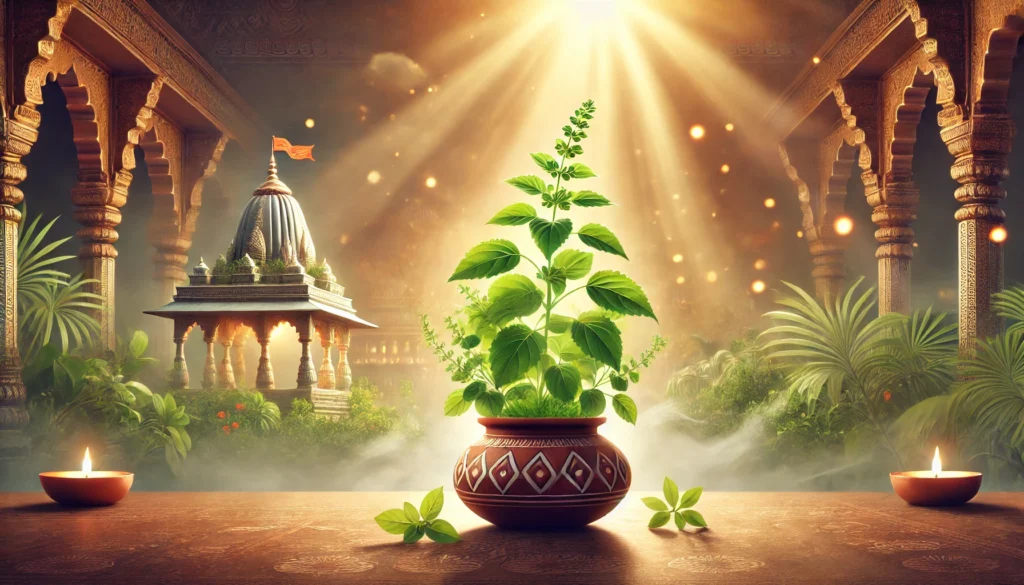Discover the spiritual and scientific significance of walking around the Tulsi plant in Hinduism. Learn how this ancient ritual enhances health, purifies the air, and promotes mindfulness, blending Ayurvedic wisdom with environmental harmony.
In Hinduism, the Tulsi plant (Ocimum sanctum) holds a revered place in homes and temples, not merely as a botanical specimen but as a sacred entity symbolizing purity, prosperity, and health. For centuries, devotees have engaged in the ritual of circumambulating the Tulsi plant, a practice deeply embedded in spiritual traditions. Yet, beyond its religious significance, modern science sheds light on the tangible health benefits of this age-old custom.

As someone who grew up in a household where the Tulsi plant was not only nurtured but venerated, I witnessed firsthand the meticulous care and devotion lavished upon this humble herb. Each morning, my grandmother would perform a pradakshina (circumambulation) around the Tulsi plant, softly reciting mantras. To the casual observer, this ritual may appear symbolic, but delving deeper reveals a fascinating confluence of spirituality and science.
Historical and Cultural Significance of Tulsi in Hinduism
Tulsi, often referred to as the “Queen of Herbs,” holds a sacred position in Hindu mythology and daily worship. According to ancient texts, the Tulsi plant is considered an earthly manifestation of the goddess Lakshmi and a consort of Lord Vishnu. The Padma Purana and Skanda Purana extol the virtues of Tulsi, emphasizing that her presence purifies the home and soul.
Temples often feature Tulsi plants in their courtyards, and homes maintain Tulsi altars, reflecting the belief that nurturing the plant invites divine blessings. Beyond mythology, Tulsi serves as a bridge connecting humanity to nature, promoting ecological balance and health.
For further insights into Hindu rituals and their symbolic meanings, visit Hindutva Online.
The Ritual of Circumambulating Tulsi
The act of walking around the Tulsi plant, known as Tulsi pradakshina, is a ritual performed at dawn or dusk. Typically, devotees circle the plant in multiples of three, five, or seven times while chanting prayers. This practice is believed to purify the surroundings, dispel negative energies, and invoke prosperity.
However, beyond spiritual merits, there lies a profound physiological and environmental dimension to this practice. Scientific studies now corroborate what ancient sages intuitively understood—the Tulsi plant possesses unparalleled medicinal and ecological properties.
Scientific Benefits of Tulsi: A Natural Air Purifier
One of the most compelling reasons for circumambulating the Tulsi plant is its ability to enhance air quality. Tulsi is known to release oxygen throughout the day, unlike most plants that predominantly emit carbon dioxide at night. This unique trait makes Tulsi a natural air purifier.
Key Benefits of Tulsi:
- Oxygen Release and Toxin Absorption: Tulsi absorbs carbon dioxide and releases oxygen, improving indoor air quality. It also neutralizes harmful gases like sulfur dioxide and carbon monoxide.
- Antimicrobial Properties: Tulsi emits essential oils with antimicrobial and antifungal properties, reducing airborne bacteria and promoting respiratory health.
- Stress Reduction: The aroma of Tulsi leaves has been shown to lower cortisol levels, fostering mental tranquility and reducing stress.
A study published by the National Center for Biotechnology Information (NCBI) found that Tulsi extract boosts immunity and mitigates respiratory issues. Learn more about the study at NCBI.
The Health Benefits of Walking Around Tulsi
Circumambulating the Tulsi plant early in the morning coincides with the period when oxygen levels are at their peak. Walking barefoot during this time allows the body to absorb negative ions from the earth, which help in reducing inflammation and enhancing mood.
Physical and Mental Benefits of Circumambulation:
- Improved Lung Function: Deep breathing during circumambulation enhances lung capacity and improves oxygen intake.
- Cardiovascular Health: Gentle walking stimulates circulation, reducing the risk of heart disease.
- Mental Clarity: Repetition of mantras while walking promotes mindfulness, grounding the practitioner in the present moment.
Anecdotally, I recall how this practice became an essential part of our family’s routine, grounding us physically and spiritually. Scientific research now validates these experiences, bridging the gap between tradition and evidence-based health practices.
Tulsi as an Ayurvedic Remedy
In Ayurveda, Tulsi is classified as a “rasayana” herb, known for its rejuvenating properties. Tulsi tea, concoctions, and essential oils are prescribed for ailments ranging from the common cold to chronic inflammation.
Common Uses of Tulsi in Ayurveda:
- Boosting Immunity: Consuming Tulsi tea enhances the body’s defense mechanisms.
- Respiratory Relief: Tulsi relieves congestion and acts as an expectorant.
- Digestive Health: Tulsi promotes healthy gut flora and alleviates indigestion.
For a comprehensive guide on Tulsi’s Ayurvedic applications, visit Ayurveda.com.
Creating a Tulsi Ritual at Home
Incorporating Tulsi into daily life can transform health and well-being. Here are some practical tips for establishing a Tulsi ritual:
- Planting Tulsi: Choose a sunny spot, as Tulsi thrives in direct sunlight. Use organic soil and ensure regular watering.
- Morning Rituals: Circumambulate the plant three to five times in the morning while reciting simple mantras such as “Om Namo Bhagavate Vasudevaya.”
- Harvesting Leaves: Pluck fresh leaves for tea or rituals, ensuring you do so with reverence and gratitude.
Cultural Revival and Modern Relevance
In recent years, there has been a resurgence of interest in traditional practices like Tulsi circumambulation, driven by a growing awareness of sustainable living and holistic health. Urban households are increasingly adopting Tulsi planting, not only for spiritual reasons but for its proven ecological benefits.
Walking around the Tulsi plant encapsulates the seamless integration of spirituality and science. As a child, this ritual grounded me in tradition; as an adult, I see it as a testament to the wisdom embedded in Hindu practices. Whether viewed through the lens of faith or scientific inquiry, Tulsi circumambulation offers a pathway to health, tranquility, and environmental harmony.
Author:
Anjali Deshmukh – Health & Wellness Expert

